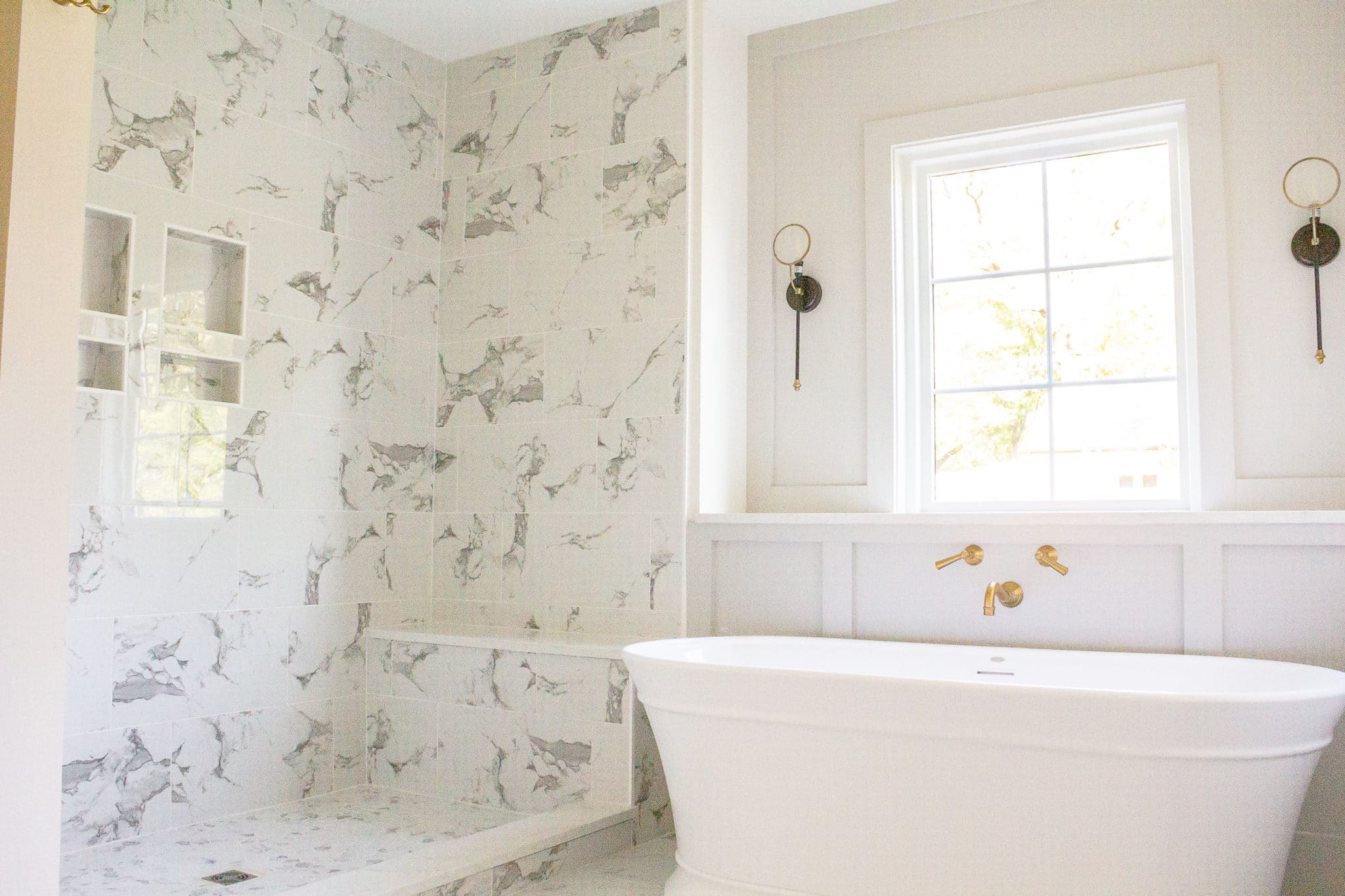I wanted to spend a blog post talking about tile. Why tile? Because it is ubiquitous in every bathroom, in every home. But more importantly, because it is a glorious design touch that can send your space into the upper echelon of style and luxury, if selected properly.
Or at least, that’s what we should be shooting for when making our tile choices.
The right tile can add character, warmth and that all-important texture that interior designers often speak about. It can operate as a wow factor and/or help unify your bathroom space.
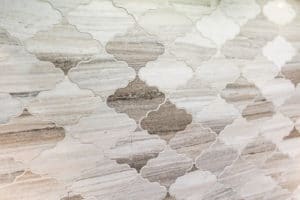
Does it sound like I’m overselling the importance of tile in your bathroom design? All I can say is trust me on this one. I’ve been in a LOT of bathrooms as an interior designer. And tile choice often is what determines whether a bathroom design will sink or swim.
Now, here’s another thing I want to stress: There’s actually quite a bit that goes into these choices. From color to pattern, size, material, and more. It’s not just a matter of walking into a tile store and pointing to something and saying “I like that.”
So when selecting tile, it definitely benefits you to have an interior designer involved in the process.
Your designer will be able to guide you through these different considerations while keeping cost and the overall “look” in mind.
Below, I will run through some of these factors, and will include some tips I often give clients when helping them with the selection process.
Note that I am focusing on the bathroom, because it is a room where tile most often takes on a starring role. But really, these tips can apply to your choices in other rooms as well. And that’s true whether you are building a new home or remodeling an existing space.
So let’s get started.
PICK THREE
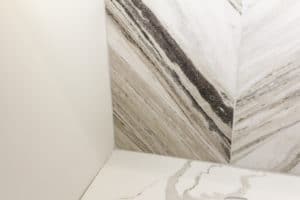
Our bathroom spaces are tile havens, partly out of necessity. You’ve got a sink, a shower, a tub and a toilet, all filled with water. So it only makes sense to have multiple surfaces within the bathroom that are water-proof.
A porcelain tile that has been properly sealed has a water absorption rate of less than 0.5 percent — so it’s a smart choice for this area of your home. (And there are other types too, which I will run through in more detail below.)
So, that’s a long winded way of getting to my point, which is that people will often have tile in multiple spots within their bathroom, for a very practical purpose. It might be inside the shower, on the floor, along the wall, behind the sink, etc.
BUT, at the end of the day, you also want it to look good. So here’s a tip: I generally advise my clients to stick to no more than three different tile looks, even if they have it in more than three areas of their bathroom.
So maybe you go with one tile in three different patterns or sizes. Or perhaps you pick one tile that is a scene stealer, and use that for the floor or wall tile, then pick a different and more subtle option for any additional surfaces, along with a smaller accent tile.
The general idea is you don’t want to overwhelm the eye with too many different looks. Again, three “looks” is the max. Maybe fewer, depending upon your tile choices.
TILE TYPE MAKES A DIFFERENCE
As I mentioned earlier, you have several options when choosing the type of tile for your bathroom.
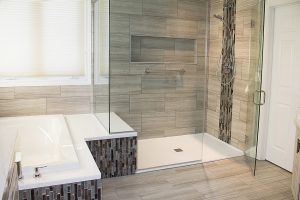
Porcelain tile is certainly the safest and most versatile option. And because they are so popular due to their durabilty, manufacturers have given customers a lot of looks to choose from in this material. They can be more expensive though, so if you are looking to save a little, you might want to consider ceramic tile.
Ceramic tile comes in a close second on durability. And it has other great attributes, such as being resistant to bacteria and odours, easy to install, and easy to clean. At quick glance, ceramic tile can be almost indiscernible from porcelain, so if you don’t care as much about having “the very best” and want to find a place to save a little money, this might be the best option for you.
Natural stone, such as limestone, travertine or slate, is also an option. This can give you a nice dose of texture and an earthy feel. Just be forewarned that natural stones are more porous, and thus less durable and more difficult to clean.
Finally, there’s glass tile. Glass tile can be stunning, but it is difficult to install and slippery, and also can be costly. So best to keep this as an accent or wall tile and use one of the other options for your floor and other larger surfaces.
TILE SIZE AND COLOR
The sky is the limit when it comes to your size and color options. I would encourage you to consider your wide variety of options here. Think about how much visual interest you can create just by changing up the size of your tile. Larger tile blocks are very popular right now, and might be a good floor option. They can be more slippery though, so maybe you switch to a smaller, mosaic pattern in the shower floor. And then perhaps you choose an in-between size for your wall or accent tile.
With this kind of sizing variety, you could play with different colors or even keep the same color and still have a ton of visual interest and texture. And on the color front, keep in mind that lighter colors tend to open up a space, while darker colors can make a room feel smaller and more enclosed. So for a bathroom that tends to be smaller anyways, you might want to stick to lighter colors.
PLAY WITH PATTERNS
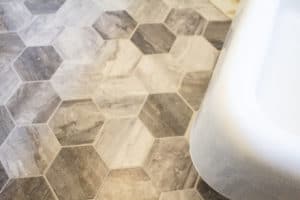
One of the best things about tile is it gives you so many opportunities to play with fun and eye-catching patterns. The more neutral your tile or look, the more adventurous you can be with your patterns.
So this is another area where you can really elevate your design.
I’ve really enjoyed seeing people grow more bold with their choices in this regard. Chevron and herringbone patterns are very on trend, as are mosaic styles and tiles with a more handpainted look. What I really like about this type of pattern play is it delivers a custom feel to your bathroom. Because bathrooms should never be boring. After all, think about how much time we spend in them!
And all that said, you also can’t go wrong with a classic subway tile. This is especially true if you have decided to go bold in some other area of your bathroom. And you can always spice this look up with a contrasting grout line.
Speaking of grout, this is another consideration that should be carefully thought out. Some people prefer to keep their grout line in a close color range to the surrounding tile, for a seamless look. That’s a safer option, for sure. But if you have a fun pattern that you want to highlight, or a more neutral tile that you’d like to add some oomph to, consider a contrasting grout color! This could really make your bathroom design pop.
IN SUM
So, there you have it! Those are some of my initial thoughts on tile selection. Of course, I could talk for hours on this subject. So if you are remodeling your home or building from scratch, please don’t hesitate to reach out! I’d love to help guide you through this process. As always, I hope everyone is staying healthy and happy, and I look forward to sharing more ideas with you soon.

